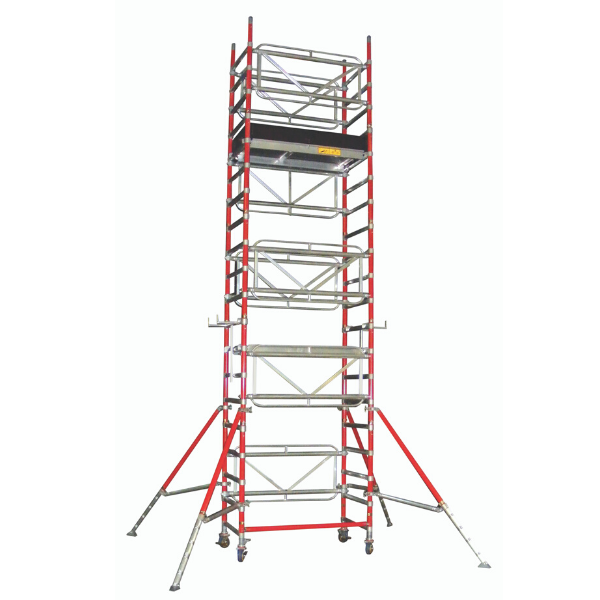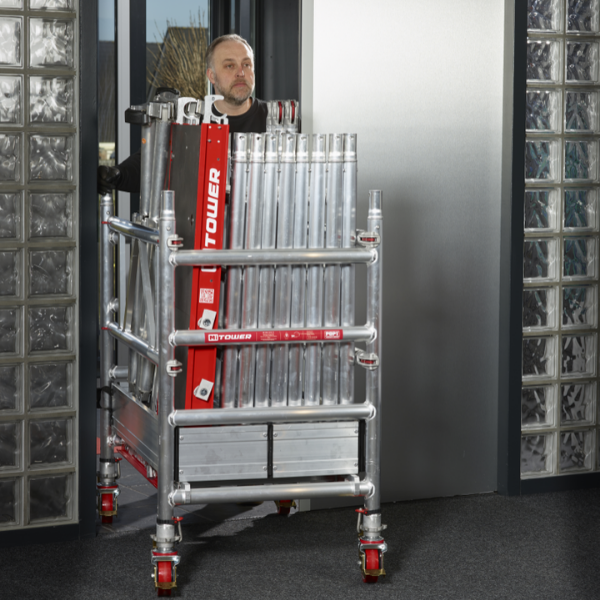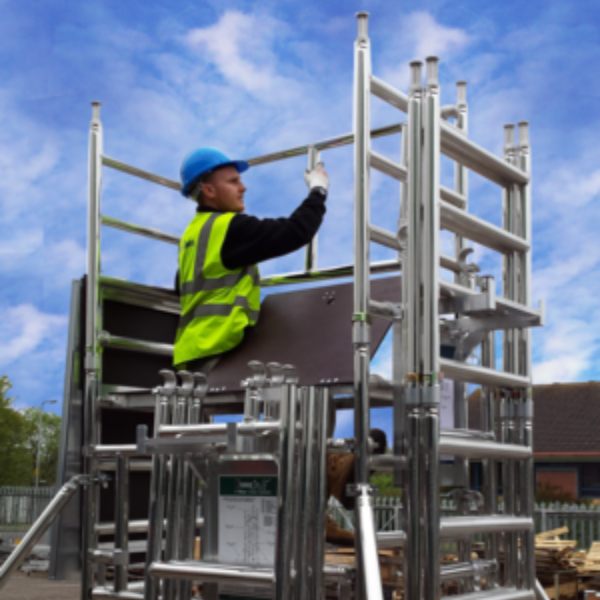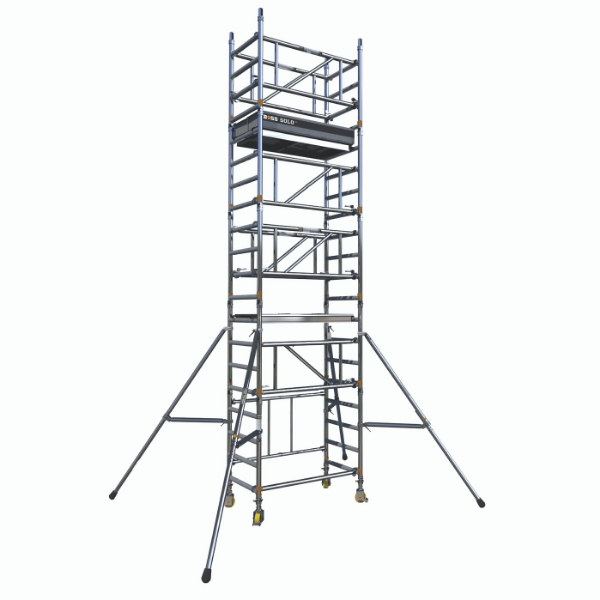Version 2 – published 2 July 2020
Working at height has always involved an element of risk, which is why it’s so important that people are trained to use scaffold towers safely. During PASMA courses, they learn how to work safely, in a way that minimises the risk of falls and injuries.
But there’s now a new risk to consider, of course, and that is the spread of coronavirus. While COVID-19 is rightly topping the health and safety agenda at the moment, height safety remains as crucial as ever. This guidance will help you keep tower users safe from falls and coronavirus in the workplace and reassure you of the measures our training centres will be taking to teach healthy habits and protect them during courses.
This guidance will not tell you exactly what to do. The truth is there’s no one-size-fits-all answer and it depends on your individual business and circumstances. For example, the resources available to you and the country you’re in. However, it will help you make your own plan for keeping tower users safe within your own business. It’s a starting point to help you figure out what you need to do.
Before we go any further, we’ll clarify that no one at PASMA is an expert on COVID-19 or minimising the risk of it spreading. We have based this guidance on our own interpretation of publicly available information from official sources in the UK that to the best of our knowledge and belief, were up-to-date and accurate at the time of writing.
We’ll also point out that our guidance relates only to the use of scaffold towers. It’s not intended to help you plan more generally for keeping staff safe in other areas of your business.
Please refer to this guidance when planning for a safe return to using towers in your workplace, but do not rely on it over and above official sources.
Towers should only be used when you’re satisfied the work can be done safely and when government guidelines for your country permit it to happen.
This section explains some key principles that should guide your approach.
Familarise yourself with the government guidance in your country, and follow it. It is likely to change regularly and it’s important you keep on top of your responsibilities and good practice. These links will help: Belgium | England | Malaysia | Netherlands | Northern Ireland | Qatar | Scotland | Singapore | South Africa | UAE | Wales
Our guidance is based on UK government sources and we advise you check it against the advice in your own country.
It’s in everyone’s interests that you facilitate good hygiene practices, for example by providing hand washing facilities (soap and water) and alcohol-based hand gel. Remind workers to cough and sneeze into their elbow or a tissue, dispose of used tissues immediately and to avoid touching their face. This is especially important when tower components and instruction manuals are being passed from one person to another or where your workers are on another company’s premises.
Consider how frequently you deep clean your own facilities, including vehicles, door handles, desks, chairs, toilets, lift buttons, handrails and equipment. We have some specific pointers relating to cleaning tower components, which you’ll find later in this document.
When you have workers on a job at another company’s premises, ask them what hygiene facilities and cleaning regime they have in place.
Safety & Health Practitioner published guidance on selecting and using the correct disinfecting chemicals and methods, which you may find helpful.
We’re all getting used to staying apart from others and this rule applies in the workplace just as it does in the supermarket or park. In the UK, government advice is to stay 2 metres (2m) apart wherever possible and that’s what our guidance is based on. However, different distances are recommended in different parts of the world and so you should check local guidelines.
Think of all the areas your workers visit between arriving and leaving your workplace or site, including toilets, vehicles, break areas, storage areas, smoking areas, prayer rooms and corridors. Walk through their journey from one area to another. What will you have to change to ensure they can stay apart from each other? How can you make it easier for them to comply? For example, removing extra chairs from break areas, introducing one-way systems and using floor stickers to mark out suitable distances.
Identify any points when you cannot facilitate the recommended distance. You must find ways to minimise the time that will be spent in closer contact and mitigate the risk by taking other precautions, for example have people side by side or facing away from each other, rather than face-to-face. Please follow government guidance carefully.
When workers are doing a job at another company’s premises or in public, remind them to keep their distance from everyone around them.
Tell your workers about the measures you’ve put in place to ensure their safety. Give them clear instructions for what to do on arrival at work, for example what time to get there and what entrance to use. Explaining what will happen should help put their mind at rest and ensure everything runs smoothly. You could highlight what hygiene facilities are on site, remind them of good hygiene practices and ask them to stay apart from others.
Tell them not to come to work if they should be self-isolating because they or a household member have experienced coronavirus symptoms.
Go over the rules and procedures with them regularly.
You might decide that the use of face masks, shields or gloves would offer some protection for your workers during any short periods when social distancing is impossible.
They may wish to wear these items for their own peace of mind, even if you do not recommend or require it.
Send workers home if they show symptoms of coronavirus, whether this is apparent on their arrival or symptoms develop during the day. Consider putting a sign on your door asking people not to enter the premises if they have symptoms. Plan how you will respond if someone does start displaying symptoms. Consider what you’d do if they needed medical attention or to be collected by someone else.
Consider what you may need to do if someone with coronavirus has been on your premises. ACAS says that the workplace does not necessarily have to close in those circumstances, but you should follow cleaning advice.
You may be required to report cases of COVID-19 under RIDDOR.
UK government advice for workplaces is that “staff should be encouraged to bring their own food.” You could also ask them to bring their own drinks, e.g. flasks of tea. Social distancing needs to be in place during break times. If space is limited, the government suggests this could be achieved by extending and staggering breaks.
Consider what toilets, smoking areas and prayer rooms workers have access to and how you can ensure cleanliness and avoid queues or crowding. Ensure there are sufficient facilities, even when social distancing is maintained, and use clear signage to direct them around the site.
The UK Health and Safety Executive (HSE) advises that good ventilation can help reduce the risk of spreading coronavirus. Where possible, open windows and doors to increase the supply of fresh air. You can also use ceiling fans or desk fans to improve the circulation of outside air and prevent pockets of stagnant air in occupied spaces.
Height safety remains as important as ever during the coronavirus outbreak. While initially suspended, PASMA training is starting to resume in areas where government guidelines allow and the training centre is satisfied they can do it safely. Centres are taking every measure possible to protect delegates from coronavirus so they can continue to train them in the safe use of scaffold towers. As always they’re teaching workers how to prevent falls and injuries back at their workplace, but while doing so they’re also now demonstrating methods of work that reduce the spread of COVID-19. To book a course, whether for now or in the future, contact your nearest training centre.
We’ve made a series of recommendations and suggestions to centres on how to adapt our courses and their facilities during this period, including:
> Social distancing measures
> Offering online theory sessions
> Using one-person towers for practical sessions
> Clear communication with delegates and clients
> Increased hygiene and cleaning
Most PASMA training involves a theory session followed by a practical session, which is the part where delegates get their hands on some towers.
The theory session for our most popular courses can be completed online, from a home computer, tablet or smartphone, in advance of the practical. It’s a series of videos and knowledge checks that the delegate works through at their own pace, delivered by an experienced instructor. Once completed, they receive a certificate to take with them to the training centre where they’ll complete a written assessment and practical session – currently they’ve got up to 90 days to do that part, but we’ll extend this if it becomes necessary. When that’s successfully done, they’ll receive their PASMA Card.
e-Learning allows people to make great progress towards a PASMA qualification, even if they’re unable to complete the practical segment just yet. It also minimises the contact time needed when they do go to a training centre. It’s a good option for employees in the UK who are on the government’s ‘furlough’ scheme too, as they can still do training (and in fact should be encouraged to do so).
The courses that currently have e-learning modules available are Towers for Users, Low Level Access and Work at Height Novice. Towers for Managers will follow shortly. To book a course that includes an e-learning module, contact your nearest training centre.
During the coronavirus outbreak, we can extend PASMA cards for up to 90 days to avoid them expiring, if the cardholder can’t get to a training centre. To qualify, they need to book a place on a future PASMA training course and complete the theory section in our Online Training Portal. When they finish the theory section, we’ll extend their card for 90 days.
We will not issue a new card, but you will be able to verify the extension by viewing the card online.
When it’s safe to visit a training centre, they’ll go there to complete the written assessment and practical session. When that’s done successfully, their card will be extended by the normal five years.
At the moment delegates are allowed a maximum of 90 days in between the theory and practical. However, we’re keeping this limit under review and will extend if it becomes necessary.
To arrange an extension, contact your nearest training centre.
We will now talk specifically about working on towers, thinking about all aspects from start to finish.
Review your risk assessment and update it to acknowledge the additional risk presented by coronavirus, for example a potentially delayed response from emergency services.
Review your rescue plan. If someone became ill or injured while working at height and needs to be rescued, your plan likely involves close contact between that person and the rescuer. Acknowledge the additional risk this now presents. Consider what you would do if there was an extended wait for an ambulance or you had to drive them to hospital. You can get further information on rescue plans for towers elsewhere on our website.
It takes two people to assemble a conventional scaffold tower and it would be natural for them work in close proximity throughout. By making a conscious effort, it’s possible to complete the task while keeping your distance, while using either the recommended 3T or Advance Guard Rail (AGR) method of assembly. For example, one person can assemble the base section and install stabilisers on their own before climbing onto the first platform and being assisted to build the rest by someone who remains on the ground.
However, a more reliable method may be using one-person towers which are specially designed to be built and dismantled by one individual working alone. These are available to buy or hire from many PASMA members.




Examples of one-person towers from (l-r) Instant Upright, Pop Up Products, Euro Towers, Boss Towers
How long does the virus that causes coronavirus live on aluminium? We don’t know, but we’ve seen some evidence that it lasts longest on shiny, hard surfaces such as plastic and stainless steel – up to 72 hours, according to a study published in the New England Journal of Medicine.
Consider deep cleaning tower components and how regularly you might do this. If you hire equipment, get it from a PASMA member who will be able to advise on their cleaning regime and other safety precautions.
Unless it’s a one-person tower that’s specially designed to be assembled by one individual, tower components will be passed between workers during assembly. Explain the risk of spreading coronavirus and why it’s so important not to touch your face and to wash your hands before and immediately after working on towers.
In the UK, the Health and Safety Executive says that equipment and work stations should be cleaned between uses.
> Social distancing, keeping businesses open and in-work activities during the coronavirus outbreak (Health and Safety Executive)
> Getting your workplace ready for COVID-19 (World Health Organisation)
> Coronavirus: advice for employers and employees (ACAS)
> The HSE has a Working Safely helpline where you can get help and advice on how to protect people from coronavirus in your workplace
> Site operating procedures protecting your workforce during coronavirus (Construction Leadership Council)
> Working safely during coronavirus outbreak (Heath and Safety Executive)
> Air conditioning and ventilation during the coronavirus outbreak (Health and Safety Executive)
> Risk assessment tool for businesses in England (UK Government)
We want your feedback on this guidance. Is it helpful? Is there anything missing? Have we got anything wrong? Have you found any innovative approaches that you want us to share with others? If you have photos of tower users socially distancing at your workplace, that would be even better.
Please let us know about any specific points in tower usage where you think social distancing will be a challenge. We will be updating and evolving this guidance as time goes on and are keen to find solutions to any problems.
Email your feedback to marketing@pasma.co.uk.
Version 1 – published 26 May 2020
Version 1.1 – published 28 May 2020 (added images of one-person towers)
Version 1.2 – published 5 June 2020 (added Table of Contents)
Version 2 – published 2 July 2020 (updated to include some additional sources that we thought would be helpful and bring it up-to-date with the latest government guidance in the UK)
Member Login Become A Member FAQs Contact
Head Office & Administration Centre
PO Box 26969
Glasgow, G3 9DR
T: +44 (0) 345 230 4041
E: info@pasma.co.uk
Prefabricated Access Suppliers’ & Manufacturers’ Association Ltd (PASMA)
is a Company Limited by Guarantee and registered in England, No. 1397880
Registered VAT No. (GB) 239 439 380.
Access Industry Management & Services Ltd (AIMS)
is a Private Limited Company, registered in England, No. 6923617
Registered VAT No. (GB) 239 439 380
is wholly owned by PASMA, and provides sales and services on behalf of PASMA to non-members.
Each have their registered address at: 167-169 Great Portland Street, 5th Floor, London, W1W 5PF.